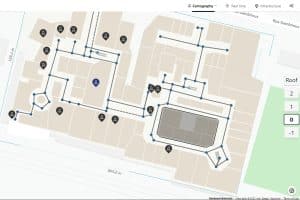

ESG monitoring is fast emerging as a fairly accurate determiner of corporate willingness to make progress towards social well-being, ecological adaptability, and sustainability. It gives an indication of climate change mitigation efforts through a mix of policy guidelines, standards, social impact, and imperatives. The contrast between blueprint and implementation, and between theory and praxis, is clearly visible through an ESG report.
Picterra, the Swiss geospatial intelligence company that uses AI and ML to turn satellite imagery to actionable insights, aims to democratize access to Earth observation, enabling businesses to react to events in a post-pandemic world and create transparent, measurable, and accountable ESG KPIs. For the year ahead, it will continue helping businesses uncover hidden application areas for geospatial intelligence that can unlock real value. From forestry management to utilities and transportation, Picterra has a footprint across multiple sectors. Some of its prominent clients include The World Bank, Westwood, Cyient, SGS, Skytec, SBB and Prorail.
Picterra is growing at a rapid pace and eyes expansion. Just yesterday, the company raised $6.5 million investment led by venture capital firm VI partners.
“C-level teams need to ensure that they have access to trustworthy, verifiable information about business activities beyond just financial data. I believe we will see more industries adopt Earth Observation imagery as a key data source to close the gap between statement and reality in their ESG reporting”, says Pierrick Poulenas, CEO, Picterra, in an exclusive interview with Geospatial World
We envision a world in which ESG reporting is more transparent and auditable than it is today. Earth Observation (EO) imagery is a good source of ground truth, so we help companies embed it into their ESG targets. For example, mining clients use Picterra to track decommissioning efforts, and consumer goods companies use it to prevent deforestation in their farm networks. We also work with a lot of foresters, especially in the carbon offsetting sector, to help them manage natural resources in a scalable way.
Underpinning the rollout of connected sensors across utility networks is the desire to modernize the grid, prevent utility loss, and optimize asset performance. Proactive monitoring of electric, gas, and oil networks relies on the combination of such data with aerial sources to give a near-real-time view of critical business assets.
As the adoption and use of autonomous drones increases, 5G and IoT ensures the rapid flow of information between connected devices and Picterra’s platform to provide early hazard detection and reduce the risk of downtime.
Location and analytics will play a critical role in the future of smart mobility and smart urbanism as city planners adopt an increasingly data-driven approach to urban design and infrastructure. The ability to analyze urban growth, traffic patterns, living preferences, building developments, infrastructure conditions, and more using geospatial ML models can ensure the evolution of smart cities to be safer, more efficient, and meet resident’s needs rapidly and accurately.
Projects such as long term sustainable agriculture in UAE and environmental initiatives to lower ammonia emissions in Denmark are very close to our heart.
The key trend will be that all organizations – regardless of sector – will consider EO imagery a critical data source. It will be as ubiquitous as ERP or CRM data is today. We already experienced a similar shift with the advent of dashboarding tools like Tableau and Qlik in the late 2000s.
When data moves into the hands of business managers with the ability to act on it, amazing things happen. Similarly, we aim to make it easy for anyone, irrespective of technical background, to use geospatial insights for making better business decisions and creating a positive ecological and social impact.
Our clients use machine learning to identify objects and segment areas in satellite, drone, and aerial images. The keyword is scale – without ML they are unable to manually count or map areas in a cost-effective way. Many of them have established drone programs to collect images, or we help them source satellite imagery from our image partners.
The software is industry agnostic, but a few examples include:
Forestry and natural resource management (e.g., SGS, Skytec) – scaling operations cost-effectively by replacing manual vegetation management processes with machine learning.
Consultancies (e.g., Cyient) using geospatial MLOps to deliver insights to clients up to 95% faster with quick prototyping of ideas.
Utilities and transportation (e.g., SBB, Prorail) – inspecting what is going on around critical infrastructures like pipelines, railways, and power lines to lower maintenance costs through preventative interventions.
ESG disclosure requirements are popping up in many new industries, not just the traditional ones. More than ever, C-level teams need to make sure they have access to trustworthy, verifiable information about the business’ activities beyond financial data. I believe we will see more industries adopt Earth Observation imagery as a key data source to close the gap between statement and reality in their ESG reporting.
Many governments lack the enforcement resources to combat deforestation and illegal logging. Using Picterra, SGS monitors the Liberian forests and alerts the authorities at any sign of illegal activity so they can take immediate action.
Shade-grown coffee not only tastes better, but it’s also produced with more sustainable farming practices that enable biodiversity to thrive. Our sustainability-conscious client monitors farmers’ transition to shade-grown coffee and the rate at which they are planting secondary crops to create more shade.
Other similar projects include ensuring long term sustainable agriculture in the UAE and an environmental initiative to lower ammonia emissions across Denmark. Projects such as these are very close to our hearts since one of our key missions as a company is to help humanity make better-informed decisions to protect our global ecosystem.



SuperWebGIS 2.1 and SuperGIS Desktop 3 can publish and read Web Map Services (WMS) in 67TM2 (EPSG:3828) and 97TM2 (EPSG:3826), said SuperGeo. These are the common coordinate system used in Taiwan. With these enhancements….

Facebook to track users’ location to be submitted to businesses. The new tool to help advertisers to send out targeted ads to potential customers.
© Geospatial Media and Communications. All Rights Reserved.